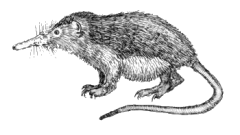Venomous mammal
Venomous mammals are a rare group within the animal kingdom, possessing the ability to produce venom and deliver it to their prey or predators. Unlike the more commonly known venomous reptiles and insects, venomous mammals are few and their venom delivery mechanisms vary significantly. This article explores the characteristics, examples, and evolutionary significance of venomous mammals.
Characteristics[edit | edit source]
Venomous mammals possess specialized anatomical structures for the production and delivery of venom. These structures can include modified teeth, salivary glands, and claws. The venom composition in mammals is diverse, often containing a complex mix of proteins, peptides, and other molecules that can immobilize prey, deter predators, or compete with rivals.
Examples[edit | edit source]
Several examples of venomous mammals highlight the diversity within this group:
- The Platypus (Ornithorhynchus anatinus) is perhaps the most well-known venomous mammal. Male platypuses have a spur on their hind limbs that can deliver a painful venom, primarily used during mating season to assert dominance over rivals.
- The European Mole (Talpa europaea) produces venom in its saliva, which it uses to paralyze prey such as earthworms, allowing it to store the still-living prey for later consumption.
- The Northern Short-tailed Shrew (Blarina brevicauda) and other shrew species have venomous saliva that they use to subdue prey. Their venom is potent enough to kill animals much larger than themselves.
- The Slow Loris (Genus: Nycticebus) is a primate with a unique method of venom delivery. It has a gland near its elbow that secretes a toxin. The loris can take the toxin into its mouth and deliver a venomous bite.
Evolutionary Significance[edit | edit source]
The evolution of venom in mammals is a subject of scientific interest and debate. It is believed that venomous traits in mammals have evolved independently multiple times across different lineages, suggesting that venom provides significant adaptive advantages in certain ecological niches. Venom can serve various functions, including predation, defense, and intraspecific competition.
Conservation[edit | edit source]
Many venomous mammals are under threat due to habitat loss, pollution, and human-wildlife conflict. Conservation efforts are crucial to protect these unique species and their ecosystems. Understanding the ecological roles of venomous mammals can aid in the development of conservation strategies.
See Also[edit | edit source]
Search WikiMD
Ad.Tired of being Overweight? Try W8MD's physician weight loss program.
Semaglutide (Ozempic / Wegovy and Tirzepatide (Mounjaro / Zepbound) available.
Advertise on WikiMD
|
WikiMD's Wellness Encyclopedia |
| Let Food Be Thy Medicine Medicine Thy Food - Hippocrates |
Translate this page: - East Asian
中文,
日本,
한국어,
South Asian
हिन्दी,
தமிழ்,
తెలుగు,
Urdu,
ಕನ್ನಡ,
Southeast Asian
Indonesian,
Vietnamese,
Thai,
မြန်မာဘာသာ,
বাংলা
European
español,
Deutsch,
français,
Greek,
português do Brasil,
polski,
română,
русский,
Nederlands,
norsk,
svenska,
suomi,
Italian
Middle Eastern & African
عربى,
Turkish,
Persian,
Hebrew,
Afrikaans,
isiZulu,
Kiswahili,
Other
Bulgarian,
Hungarian,
Czech,
Swedish,
മലയാളം,
मराठी,
ਪੰਜਾਬੀ,
ગુજરાતી,
Portuguese,
Ukrainian
Medical Disclaimer: WikiMD is not a substitute for professional medical advice. The information on WikiMD is provided as an information resource only, may be incorrect, outdated or misleading, and is not to be used or relied on for any diagnostic or treatment purposes. Please consult your health care provider before making any healthcare decisions or for guidance about a specific medical condition. WikiMD expressly disclaims responsibility, and shall have no liability, for any damages, loss, injury, or liability whatsoever suffered as a result of your reliance on the information contained in this site. By visiting this site you agree to the foregoing terms and conditions, which may from time to time be changed or supplemented by WikiMD. If you do not agree to the foregoing terms and conditions, you should not enter or use this site. See full disclaimer.
Credits:Most images are courtesy of Wikimedia commons, and templates, categories Wikipedia, licensed under CC BY SA or similar.
Contributors: Prab R. Tumpati, MD




